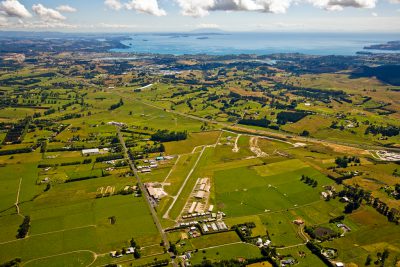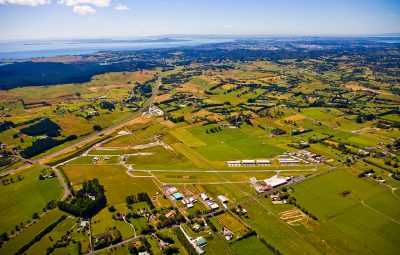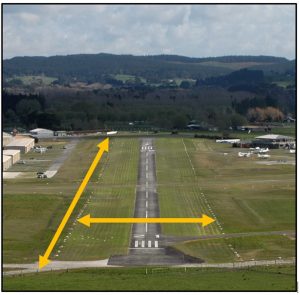Fixed-Wing
North Shore Airport is a private aerodrome, but we welcome itinerant aircraft not based at the aerodrome with prior approval. To gain approval, please complete the online application form.
Once the online form is submitted, automatic approval will be given and confirmed via email, unless your flight does not meet the automatic approval criteria (please note commercial operations are not able to be approved automatically at this time – if you register a commercial flight, you will be directed to contact the airport for approval). Commercial operations are considered to be any flight for hire or reward, including all flight training activities. All approvals are subject to compliance with the operational requirements specified within the AIPNZ, and any active NOTAMs.
Visiting pilots and their passengers are welcome to use the NSAC clubhouse facilities including the toilets, kitchen and observation deck.
A landing fee of $20 per landing applies for all aircraft not based at NZNE. The overnight parking fee is $35 per night. All charges are invoiced.
Commercial Operators
Commercial operations are welcome, however due to the private nature of the airport, all flights require prior approval. To gain approval, complete the online approval request form, and contact the airport as per the instructions.
A landing fee of $50 per landing applies to all commercial activities. All charges are invoiced.
Helicopters
As per the AIPNZ, all operations by helicopters not based at NZNE, both private and commercial (except emergency flights) require written approval. To request approval, email all relevant details to [email protected]
Pilots are encouraged to familiarise themselves with the Aircraft Operations Guide below. To download this as a PDF click here.

Aircraft Operations Guide
Section 1 – Foreword
The intention of this document is to provide detailed guidance to pilots operating at North Shore Aerodrome.
This document in no way supersedes the information, procedures, and requirements promulgated by the AIPNZ, nor does it absolve pilots from compliance with the AIPNZ. Any charts and diagrams contained in this document are not for operational use.
This document, the recommendations and the procedures contained herein DO NOT absolve pilots from compliance with the Civil Aviation Act, associated rules and regulations.
Section 2 – Definitions and Abbreviations
Additional definitions and abbreviations are contained within CAR Part 1.
Part 1 – Definitions
- ‘Civil Aviation Act’ means the law enacted for the regulation and control of civil aviation activities within New Zealand.
- ‘Aerodrome’ means the area designed to be used by aircraft, for the purpose of taking off, landing, and surface movements, including all buildings and hangars used in connection with the aerodrome.
- ‘Movement Area’ means the manoeuvring area, aprons, and other areas used for aircraft surface movements.
- ‘Manoeuvring Areas’ means the runways and taxiways.
- ‘Vicinity’ means the area immediately surrounding the aerodrome, within a 2NM lateral radius, and extending to 1,500 ft above aerodrome level.
- ‘Incident’ means any occurrence, other than an accident, that is associated with the operation of an aircraft and affects or could affect the safety of operation.
- ‘Accident’ means an occurrence in which a person/s is injured, or an aircraft sustains damage.
Part 2 – Abbreviations
- CAA – Civil Aviation Authority of New Zealand
- CAR – Civil Aviation Rule
- AIPNZ – Aeronautical Information Publication New Zealand
- VNC – Visual Navigation Chart
- NSAC – North Shore Aero Club (the Airport Operator)
- NSA – North Shore Airport
- NZNE – the ICAO code for North Shore Aerodrome
- ICAO – International Civil Aviation Organisation
- CFI – Chief Flying Instructor of NSAC
- NORDO – No Radio
- SOHJ – Standard Overhead Join
- AMSL – Above Mean Sea Level
- NOTAM – Notices to Airman
- ERP – Emergency Response Plan
Section 3 – General Aircraft Operating Procedures
NZNE is one of the busiest unattended aerodromes in New Zealand, catering for intensive fixed-wing and helicopter recreational, training, and commercial operations. To facilitate the safe operation of all aircraft at NZNE, the recommendations contained in this guide should be complied with.
The airport is not equipped with a Flight Service or UNICOM to assist pilots. All pilots are responsible for safe separation and for managing the risk of conflict. See and avoid principles, and the use of standard procedures are vital elements of ensuring flight safety at the airport.
By law, ALL aircraft are required to comply with the procedures promulgated in the AIPNZ for North Shore Aerodrome. ALL aircraft shall comply with CAR Part 91 General Operating and Flight Rules. See https://www.aviation.govt.nz/rules/rule-part/show/91
It must be appreciated by all pilots that compliance is not voluntary – it is compulsory. As is compliance with all procedures promulgated by the AIPNZ. Calling “non-standard” on the radio frequency DOES NOT absolve compliance. The use of standard procedures is vital to ensure the safety of operations at the airport, and within the vicinity. In addition to compliance with standard procedures, right-of-way rules must be observed at all times.
In accordance with Civil Aviation Rules, pilots must check NOTAMs and the AIP Supplement prior to flight to ensure compliance, and to remain aware of hazards to flight safety. A current hazard register is on display in the club flight office, and is available online – see: https://my.nsac.co.nz/Hazards/Active
As NZNE is a private aerodrome, all operations by aircraft not based at the aerodrome require prior approval. See the AIPNZ for details.
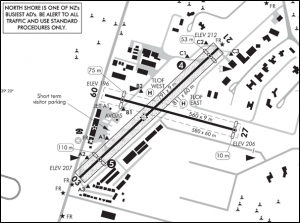
Part 1 – VFR Arrivals and Joining the Circuit
All aircraft shall arrive and join the circuit pattern in accordance with standard procedures. Due to traffic density pilots are requested to use SOHJ procedures. Overhead joining altitude is 1,700 ft AMSL. An AWIB providing wind strength and direction, mean sea level pressure, temperature, dew point, and other advisories, is available on frequency 130.45MHz.
At NZNE the vicinity of the aerodrome is a 2NM radius originating from the aerodrome reference point (ARP). In accordance with Civil Aviation Rules, non-standard procedures are prohibited — aircraft must not make right turns whether arriving or departing, for any runway, within the vicinity of the aerodrome.
Aircraft should not join straight in for any runway, unless utilising the recommended helicopter arrival procedures runway 09 and 27 or engaged on an instrument approach runway 03 or 21.
All aircraft:
- Monitor the AWIB.
- Change to 118.00MHz early to ascertain the runway-in-use and the position of aircraft operating.
- Clear, concise, and accurate joining radio calls should be made prior to joining. The use of Visual Reporting Points (VRP) or other prominent points is recommended. Otherwise, aircraft should state their distance from the aerodrome.
Fixed Wing:
- Join using Standard Overhead Joining procedures (preferred).
- Straight-in approaches for any runway are not permitted, except aircraft engaged on the instrument approach.
- Aircraft joining down wind or base leg must be established on the extension of the leg prior to entering the vicinity of the aerodrome.
- Give way to aircraft ahead and aircraft established in the circuit.
Helicopters:
- Join in accordance with the preferred helicopter arrival procedure RWY 09 or 27, remaining clear of the fixed wing circuit (see Figure 1).
- Otherwise, join in accordance with fixed wing joining procedures RWY 03 or21.
- Straight-in approaches for RWY 03 or 21 are not permitted, except aircraft engaged on the instrument approach.
- Give way to aircraft ahead and aircraft established in the circuit.
- Prior to crossing runway 03 or 21, helicopters must transition to a hover-taxi, and ensure it is clear before crossing*. TLOF East and West should be utilised.
*Helicopter wake turbulence must be considered prior to crossing runways being utilised by fixed wing aircraft in particular. Helicopters should not cross ahead of aircraft on final approach.
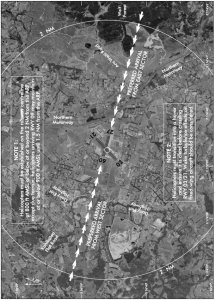
Figure 1.
Part 2 – VFR Departing and Vacating the Circuit
All aircraft shall depart, and vacate the circuit pattern in accordance with standard procedures. In accordance with Civil Aviation Rules, non-standard procedures are prohibited — aircraft must not make right turns when departing until clear of the vicinity of the aerodrome (2NM from the APR, or above an altitude of 1,700 ft AMSL), unless departing in accordance with the standard instrument departure procedure.
All aircraft:
- Monitor the AWIB.
- Change to 118.00MHz early to ascertain the runway-in-use and the position of aircraft operating.
- Call 118.00MHz prior to taxi.
Fixed Wing:
- Depart the circuit in accordance with standard procedures.
- To remain clear of aircraft joining overhead, maintain circuit altitude until clear of the vicinity of the aerodrome unless departing straight-out.
Helicopters:
- Depart in accordance with the preferred helicopter departure procedure RWY 09 or 27, remaining clear of the fixed wing circuit (see Figure 2).
- Otherwise, depart in accordance with fixed wing departure procedures RWY 03 or21.
- Ensure it is clear prior to crossing RWY 03/21*.
*Helicopter wake turbulence must be considered prior to crossing runways being utilised by fixed wing aircraft in particular. Helicopters should not cross ahead of aircraft on final approach.
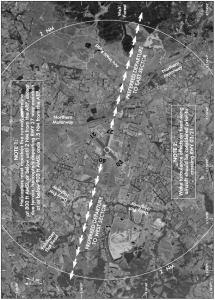
Figure 2.
Part 3 – Circuit Operations
All circuit patterns at NZNE are left-hand. Circuit pattern altitudes are:
- Fixed-wing 1,200 ft AMSL
- Helicopters 800 ft AMSL
Aircraft joining and established in the circuit must not exceed 120KIAS or minimum safe speed. Aircraft not capable of maintaining 70KIAS or above should utilize the helicopter circuit altitude of 800 ft AMSL.
Low-level circuits should only be conducted when the circuit pattern is quiet, and when there is no risk of conflict with other aircraft operating. Aircraft ahead in the circuit retain right-of-way unless mutually agreed via the radio frequency. Student pilots are not permitted to conduct low-level circuits during solo flights. Low-level circuits must not be conducted when the recommended helicopter arrival and departure procedures are being utilised.
When operating in the circuit pattern, a radio call should be made downwind abeam the upwind threshold, and when established on final. In order to maintain the integrity of the approach sequence, it may be necessary to make a radio call on the base leg, or at any other time it is required.
Aircraft are encouraged to call their landing sequence in the circuit i.e. “North Shore Traffic, ABC, downwind runway 21, number 3”.
Extreme care must be taken when simultaneous circuit operations utilising both runway 03 or 21 and runway 09 or 27 are being conduct. It is preferred simultaneous circuits are only flown when dual with an instructor, and when it is absolutely necessary to do so.
Part 4 – Taking Off and Landing
Only the defined runway area as promulgated by the AIPNZ may be used for taking-off and landing. For runway 03 and 21, the confines of each runway are marked by white tyres – the runway width extends from ‘tyres to tyres’. The width and length of runway 03/21 is shown by figure 3. Figure 4 depicts the confines of the runway 03/21 as outlined in yellow. Runway 09/27 is a gravel runway only, and the grass must not be used for aircraft movements.
Figure 3. Figure 4.
At NZNE all grass areas become extremely soft over the winter months, and unsuitable for aircraft movements. All grass areas are NOTAM’d closed when surface conditions become unsuitable. The period of closure of the grass runways normally extends from mid-May to mid-November, however this is not always the case.
Aircraft must not take-off or land if an aircraft, vehicle, person, or other obstruction is present within the runway area. This includes the grass runways, and whether they are closed or not. Parallel take-off and landing operations runway 03/21 are not permitted.
Prior to take-off, aircraft should minimise time spent on the active runway as much as it is safe to do so, and should vacate the runway as soon as practical after landing. After landing runway 21, aircraft vacating the runway via holding position A3 to the southern hangars can often spend a significant amount of time obstructing the runway. In such instances, and in particular when the circuit is busy, it may be necessary to vacate the runway, then taxi to southern hangars via the taxiway system.
Given runway length, aircraft performance factors should be considered – especially when operating at Maximum All Up Weight, and when the ambient temperature is high. Terrain and other obstacles are present after take-off, therefore climb performance should also be considered. Appropriate decision and abort points should be used.
Runway 09/27 is 231m shorter than runway 03/21, and the gravel section of the runway provides reduced braking action – pilots should expect increased stopping distance during landing roll, and in the event of an aborted take-off. The gravel portion of runway 09/27 is normally suitable for aircraft operations year-round. Due to the airport’s topography, it may not be possible to sight aircraft lining up runway 27.
Engine failure after take-off field options are limited (runway 03 in particular). Accordingly, pilots are encouraged to brief their actions prior to take-off.
Part 5 – Circuit Safety
All aerodrome users have a joint responsibility and obligation to conduct their flights as safely as possible, while being considerate of all aerodrome users.
Safety occurrences, incidents, and accidents are normally a result of failure to comply with standard procedures, failure to maintain a thorough and consistent lookout, or a failure to behave in a courteous manner maintaining a high-level of airmanship.
Part 6 – Night Operations
Night flying operations are particularly challenging at NZNE, predominantly due to a short and narrow runway, soft ground, a lack of taxiway lighting, terrain, and other obstructions, and without an approach profile lighting system.
We recommend a dual check is conducted before solo flight at night at NZNE for the first time.
For night operations, please note the following:
- The runway lights are activated via a Pilot Activated Lighting (PAL) system.
- To activate the lights, transmit 5 clear pulses over the radio frequency within 3 seconds.
- Once activated, the runway lights will remain on for 30 minutes.
- In an emergency, the runway lighting may be activated by text message – please consult with a club instructor who will advise the current details of this system.
- Runway edge lights, and solar runway centerline lights are spaced at 45m intervals.
- Caution – the runway edge lighting is positioned at the edge of the grass runway, not the concrete strip.
- The runway 21 threshold is displaced a further 182m at night.
- Amber wing-bar lights are positioned halfway in between runway 03 and 21 thresholds.
- There is no taxiway lighting – pilots should use the aircrafts taxi or landing light while taxiing at night.
- A mandatory aerodrome curfew is in force daily from 2230 hours to MCT local time, except emergency flights.
Part 7 – IFR Operations
IFR operations are conducted regularly. Aircraft departing IFR will maintain runway centerline until reaching a minimum altitude of 800 ft AMSL (runway 03) or 1,000 ft AMSL (runway 21) before turning left or right to intercept their flight planned track.
IFR arrival and approach procedures are carried out from the northeast and southwest – the final approach paths being indicated by the elongated teardrop symbols on the VNC (see figure 5). The approach commencement point runway 03, ‘LIBKO’, is 8NM southwest of the aerodrome (see figure 6). The approach commencement point runway 21, ‘UPLIN’, is 10NM northeast of the aerodrome (see figure 7).
Circling approaches often conducted; IFR aircraft will either break off the approach and position downwind for the opposite runway, or overfly the runway and then turn downwind.
Unless weather conditions dictate otherwise, aircraft engaged on an instrument approach will give way to aircraft established in the circuit.
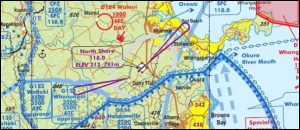
Figure 5.
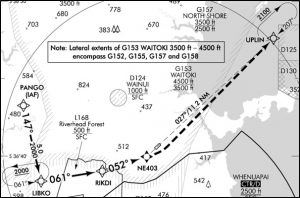
Figure 6.
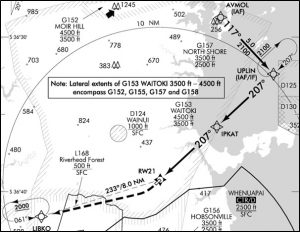
Figure 7.
Part 8 – Radio Frequency
As a designated discrete frequency, “North Shore Traffic” may be omitted from the beginning of radio transmissions to minimise impedance when the frequency is busy.
Pilots must be aware that NORDO aircraft may be operating at any time. Aircraft not equipped with a transponder or ADS-B may also be operating.
Section 4 – Ground Movements
Due to the space-restricted nature of ground movements at NZNE, it is important to be courteous and patient. Care must be taken when taxiing near other aircraft, people, and vehicles.
Part 1 – Taxiing
Taxiing should be confined to paved areas only. All grass areas are soft when wet, particularly over the winter period and following heavy rain. Grass areas are not prepared for aircraft movements and may present a prop-strike hazard.
Cutting corners between adjoining taxiways, and not diligently maintaining the taxiway centerline commonly results in becoming stuck. If your aircraft becomes stuck, do not try to ‘power out’ – this will only drive the aircraft deeper into soft ground. Rather, shut down and push the aircraft back onto the taxiway, or call “North Shore Base” on 118.00MHz for assistance.
As per the AIPNZ, the taxiway between holding points A1 and A2 is limited to aircraft with a maximum wingspan of 12m. See figure 8.
Due slipstream, caution should be exercised when taxiing close to parked aircraft and open hangars.
Whilst not always necessary, a taxiing radio call may be helpful in instances of limited visibility of ground movements (taxiing from behind a row of hangars for example).
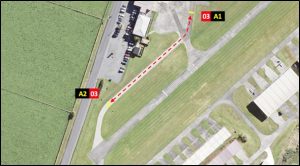
Figure 8.
Part 2 – Run-Ups
Run-ups should be conducted in the locations circled red on figure 9. Before running-up, pilots are reminded to ensure the area immediately below the propeller is clear of stones and other debris, and that the slipstream generated will not affect aircraft, persons, open hangars, or any other object behind the aircraft. Noise is also a consideration, and effort should be a made to run-up away from occupied buildings.
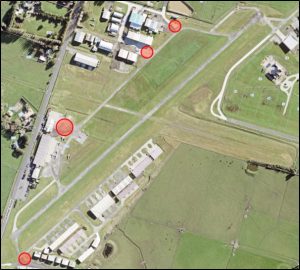
Figure 9.
Part 3 – Refueling
Pilots should taxi in an anti-clockwise direction around the fuel pumps to allow for good wing-tip visibility. Caution must be exercised when taxiing between the pumps, and helicopters parked on the helipads.
Helicopters parking on the helipads at the AVGAS fuel pumps must ensure the full length of their skids are behind the white line across the helipad (see figure 10).
Pilots should not leave aircraft unattended at the fuel pumps.
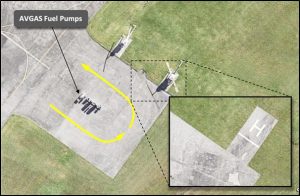
Figure 10.
Part 4 – Parking
Always park aircraft clear of taxiways and other movement areas.
Visitor parking stands are available opposite the club apron (see figure 11). Pilots must ensure their aircraft is pushed back as far as possible to provide maximum taxiway clearance.
The apron adjacent to the club hangar is reserved for club aircraft, and aircraft resident in the club hangar. To minimise the risk of damage to aircraft, pilots should not taxi between the club hangar, and aircraft parked on the apron.
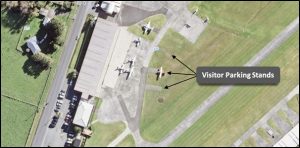
Figure 11.
Part 5 – Holding Procedures
To facilitate smooth and efficient ground operations, the following holding procedures should be utilised by pilots prior to take-off:
- All club and training aircraft should hold at Holding Point A2 runway 03, or C2 runway 21.
- At their discretion, other aircraft (including commercial operators), should hold at Holding Point A1 runway 03, or C1 runway 21.
- When ready to line up, and after coordinating with the aircraft at Holding Point A2 or C2,the aircraft holding at A1 or C1 may backtrack the runway and line up ahead.
Figures 12 and 13 depict the procedure that should be used, for runway 03 and runway 21 respectively.
Pilots are reminded not to rush vital pre-take-off checks and procedures.
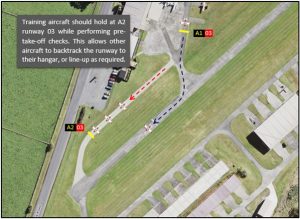
Figure 12.
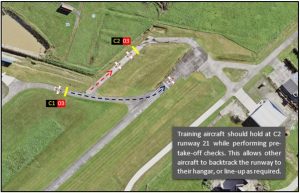
Figure 13.
Section 5 – Other Activities
Part 1 – Flight Training
Intensive flight training activities are carried out at the aerodrome and within the North Shore CFZ. All pilots operating should be mindful of pilots of varying levels of experience, including solo student pilots, and the effects their actions may have. As role models, it is requested pilots always demonstrate a high level of airmanship and behave in a safe and responsible manner.
Typical emergency simulations conducted by training flights are Engine Failure After Take-Off (EFATO), Glide Approach, and Aborted Take-off. EFATO simulations are conducted upwind after take-off, normally commencing at or above 500 ft AMSL. EFATO simulations last between 10 and 20 seconds, and result in a go-around not below 400 ft AMSL. Aircraft will re-join the circuit crosswind, or early downwind.
Glide Approaches commence downwind, typically abeam the landing threshold. Aborted take-off simulations are conducted during the take-off roll prior to the aircraft becoming airborne. At times, these simulations may be conducted using the opposite (tailwind) runway if circuit traffic allows.
Typical radio calls are:
EFATO: “NS Traffic, TZG, airborne runway 21, simulating, call again climbing.”, and
“NS Traffic, TZG, climbing away, re-joining crosswind runway 21.”
Glide Approach: “NS Traffic, TZG, late downwind runway 21, glide approach.”
Aborted Take-Off: “NS Traffic, TZG, rolling runway 21, simulating aborted take-off.”
Part 2 – Aerobatics
Aerobatic flight is permitted to take place overhead NZNE, however pilots should not plan to conduct aerobatic flight below 2,700 ft AMSL, to provide sufficient separation from aircraft joining overhead.
Aerobatics above the aerodrome below 2,700 ft AMSL may be approved by the CFI on a case-by-case basis for the purpose of official display or competition practice.
Part 3 – Helicopter Operations
Extensive commercial, training, private, and emergency helicopter operations are carried out at the aerodrome, which require particular consideration.
Due to noise and space requirements, it is recommended large helicopters use the fixed-wing circuit, and circuit altitude (1,200 ft AMSL). Helicopter operations at night must utilise the fixed-wing circuit.
Helicopter pilots must consider the potential effects of their wake turbulence, particularly in light wind conditions. Helicopters are asked to avoid hovering, or hover-taxiing close to open hangars, or close to the runway in use, considering wind drift.
Helicopters must exercise caution when landing and lifting from the Jet A1 or AVGAS helipads due to the proximity of fixed-wing aircraft parked on the apron adjacent the Airport Terminal and other aircraft using the refueling area.
Helicopter training activities are conducted extensively. Hovering exercises are normally conducted at the TLOF East or West, and the eastern portion of runway 09/27 (if the runway is not in use). Fixed-wing aircraft must be aware of helicopters transitioning (normally via hover-taxi) between different locations on the aerodrome. Whilst helicopters will use runway 09/27 for training exercises where possible, the following exercises (including, but not limited to) will be flown to the into wind runway:
- Autorotation’s as a result of simulated engine failures
- Tail Rotor pedal jam simulations
- Tail Rotor failure simulations
- Hydraulic failure simulations
- Limited power operations and simulations
Autorotation’s could be conducted straight in, or from a close-in downwind position. The other exercises listed above involve slower than normal approach speeds and occupation of the runway area for a longer period. Helicopter and fixed-wing pilots should be mindful of these circumstances and, space-out accordingly. Helicopters should vacate the active runway as soon as practical after the conclusion of training exercises.
Pilots are encouraged to announce their intentions using the radio frequency so that other users operating in the circuit can maintain situational awareness. Typical radio calls are:
180-degree Autorotation: “NS Traffic, HEK, downwind runway 21, practice 180 autorotation to the intersection of the runways.”
Straight-in Autorotation: “NS Traffic, HEK, final runway 21, 1000ft, practice autorotation to the seal.”
Other exercises: “NS Traffic, HEK, final runway 21, simulated hydraulics failure, run on landing to the seal.”
Part 4 – Commercial Operators
Several commercial operators use the aerodrome, as well as emergency service flights and the RNZAF/RNZN.
The majority of commercial fixed-wing aircraft operations are conducted between NZNE and Great Barrier Island. To avoid conflict with Air Transport flights, recreational flights between NZNE and Great Barrier Island should use the following cruising levels:
- NZNE – Great Barrier: 2,500 ft AMSL
- Great Barrier – NZNE: 2,000 ft AMSL
The airport terminal and apron used by commercial operators is immediately north of the club hangar.
Part 5 – RPAS
Remotely Piloted Aircraft Systems (RPAS) commonly referred to as UAV’s or Drones, sometimes operate within the vicinity of the aerodrome. RPAS flights approved by the CFI are normally conducted by certificated Part 102 RPAS operators, and mainly for the purpose of real estate photography or aerial surveying. If necessary, a NOTAM advising the location, height, and duration of an RPAS flight will be promulgated.
All pilots must be aware that unknown and unauthorised drone activities may be present, requiring vigilance to be exercised at all times.
Section 6 – Local Considerations
Part 1 – Weather
At NZNE the predominant wind direction is southwest, favouring runway 21. Sea breezes are common during summer months, and tend to initiate late morning to early afternoon, blowing from the NNE at 5 to 15 knots.
Turbulence and wind shear can be expected on approach to runway 21 in SW/W/NW wind conditions. Mechanical turbulence can be expected due to the proximity of structures on the aerodrome to the runway – especially in westerly and easterly wind conditions. Downdrafts can be encountered in the lee of the East Coast Road ridgeline while on final approach runway 21, especially when low on the approach profile.
Low cloud will often form over the aerodrome in frontal, and in moist northerly and easterly wind conditions. Low cloud tends to rest on the higher terrain around the aerodrome. Radiation fog is a usual occurrence at the aerodrome during colder months. Radiation fog is usually at its worst in the early morning and after sunrise but does commonly form at night.
When planning night flying, the temperature and dew point split should be monitored carefully. Fog will usually begin to form in the middle of the aerodrome (lowest-lying ground), often being noticed first around the runway edge lights. Advection fog is occasionally prevalent, moving towards the aerodrome from the north or east, but normally doesn’t extend inland beyond the aerodrome.
After heavy rain aquaplaning can occur on the sealed portion of runway 03/21 due to the non-porous concrete surface. Surface flooding also occurs at times.
Part 2 – Airspace
At its closest point, the Whenuapai CTR/D boundary is 2NM east-southeast of NZNE. If transiting the CTR/D to NZNE, a late change to the NZNE aerodrome frequency is inevitable. In such cases a SOHJ is recommended to ensure pilots develop proper awareness of affecting traffic before joining the circuit. Caution – helicopters may make a late radio call if arriving from the south, via the helicopter arrival procedure runway 27.
VFR Transit Lanes are provided on the eastern and western side of the WP CTR/D. The upper limit of T159 (east) is 1,200 ft AMSL. T159 is a busy thoroughfare for aircraft transiting north or south along the coast. As per the VNC, aircraft utilizing T159 should transit in accordance with the blue arrows to provide greater separation between northbound and southbound aircraft. T158 (west) has an upper limit of 2,000 ft AMSL.
By day, the North Shore General Aviation Area (GAA) G157 is active from 2,500 ft AMSL to 3,500 ft AMSL. The eastern boundary of G157 does not follow the boundary of the North Shore CFZ – caution must be exercised to ensure Auckland’s CTA/C is not infringed in this area if operating above 2,500 ft AMSL.
Danger Area D130 (Whangaparaoa Head) is active 24hrs from the surface to 1,200 ft AMSL for the purpose of live firing activities. D125 (Tiritiri Island) is activated by NOTAM. Caution – when active, D125 conflicts for the North Shore – Great Barrier track, the instrument approach runway 21, and the instrument missed approach runway 03. D124 (Wainui) is active by day, due model aircraft flying activities.
One of New Zealand’s busiest Parachute Landing Areas (PLA) is active daily at Parakai Aerodrome (NZPI). While flying enroute, avoid the Parakai MBZ to remain clear of parachuting activities. If landing at NZPI, do not join overhead and follow the procedures contained in the AIPNZ.
Low Flying Zone L165 is administered by NSAC and Rodney Aero Club (RAC). Only dual flights approved by NSAC or RAC may enter L165.
Part 3 – High Traffic Volume Areas
Extensive flight training is carried out seaward of the eastern coastline between Orewa and the Mahurangi Peninsula, between 500 ft and 3,500 ft AMSL. To the west of NZNE, the areas encompassing Wainui and Waitoki are also heavily used for flight training, and forced landing simulations.
A large number of aircraft transit north/south along the east coast between Okura River Mouth and the Mahurangi Harbour. Aircraft approaching NZNE to join the circuit often transit via Orewa and the Okura River Mouth. Okura River Mouth represents a choke point where aircraft enter and exit the transit lane T157.
Part 4 – Wildlife
Birds are regularly present at the aerodrome, most prolifically the Spur-Winged Plover. Other bird species including Ducks, Pukekos, and Canada Geese are also present.
Various bird controls measures are in place, however if a bird strike occurs it is required to be reported to the CAA, and it is the responsibility of the PIC to do so. CAA form CAA005B should be used: https://www.aviation.govt.nz/assets/forms/CA005B_Form.pdf A copy of the report should be forwarded to NSAC.
Section 7 – Accidents and Incidents
Detailed guidance and procedures are contained in NSAC’s Safety Management Manual. A copy of this manual can be found here: https://www.nsac.co.nz/safety/
An airport safety induction video can be viewed via the same link
Part 1 – General
In the event of an accident or incident, attend to your passengers, keep them safe from any immediate danger, and ensure the aircraft is secure – NSAC staff will initiate the Aerodrome ERP. Follow the instructions of the designated Accident Controller, or delegate. Do not move the aircraft until you are cleared to do so by the CAA or NSAC staff.
First aid is available at the club house, as well as an Automated External Defibrillator (AED). Fire extinguishers are available in the red cupboard beside the club’s main entrance to the apron (as well as an axe), and at the location of each fuel pump. Spill kits are also available in those locations.
Part 2 – Reporting
Pilots are encouraged to report all occurrences at the aerodrome, or within its vicinity via NSAC’s reporting system which can be accessed here via the NSAC website: https://www.nsac.co.nz/safety/
At NSAC and NZNE we promote a Just Culture. Information reported will be used for safety education, and to reduce safety risk at the airport.
Part 3 – Aerodrome ERP
The following procedure is a summarised overview of the aerodrome ERP in place at NZNE. In the event of an accident OR potential danger to life or property on the airport or immediate boundary, the following procedures are carried out:
- Details of the accident will be determined to confirm that an accident or major incident has occurred.
IN THE EVENT OF AN ACCIDENT OR INCIDENT the most senior NSAC staff member on duty becomes the ACCIDENT CONTROLLER (an ACCIDENT CONTROLLER Drop List is displayed at the club), and will proceed as follows:
- The ACCIDENT CONTROLLER will refer to the AIRPORT EMERGENCY PLAN checklist the NSAC office commencing with the ‘Step 1’ Checklist.
- The ACCIDENT CONTROLLER will nominate and brief a SITE ASSESSOR (‘Step 2’ Checklist). The SITE ASSESSOR will:
- Ensure they have the SITE ASSESSOR checklist
- Not move aircraft UNLESS it endangers life
- Not move injured people unnecessarily
- Provide additional details to Emergency Services enroute if necessary
- Stabilise the situation where possible. Ensure non-essential people are kept away from the scene of the accident
If FIRE SERVICE required Dial 111 disclosing the following:
- a) Ask for FIRE SERVICE
- b) Name and location of Airport
- c) Nature of incident e.g. crash, hazardous landing, fuel spillage, etc.
- d) Number of people involved
- e) Location of accident in relation to Airport e.g. Runway 03, Southern Hangars
- f) Which Airport Emergency Gate to use (See Emergency Vehicle Access Coordinator check list, on office rear wall.)
POLICE and AMBULANCE SERVICES WILL BE NOTIFIED AUTOMATICALLY
(From receipt of call the Fire Service will arrive in approximately 12 minutes)
- The ACCIDENT CONTROLLER will nominate and brief EMERGENCY ACCESS COORDINATOR (‘Step 3’ Checklist) and dispatch to the appropriate gate/gates.
The EMERGENCY ACCESS COORDINATOR will carry out the following action upon the arrival of Emergency Services:
- a) Provide Emergency Services with an update on account of incident.
- b) Advise whether Airport is open or closed.
- c) Inform Fire Officer of water resources.
IN THE EVENT OF A FALSE ALARM OR STABILISED SITUATION THE FIRE SERVICE SHOULD BE INFORMED BY DIALING: Fire Service 09 307 7821
- The ACCIDENT CONTROLLER will delegate an OFFICE COORDINATOR (‘Step 4’ checklist).
- North Shore Traffic will be notified of situation 118.00.
- The Airport will be closed if necessary.
- A person will be nominated to control members of the public.
- The CEO and CFI will be contacted, as well at the Club President and Vice-President.
- The media coordinator will be briefed (CEO or CFI)
- If possible, the aircraft owner and maintenance provider will be advised.
- Accident details will be recorded on the Aircraft Accident Notification Form.
- CAA will be advised without delay the details contained in the form, phone 04 560 9400. This is a 24-hour number.
- A POST INCIDENT CHECKLIST is carried out.
NOTES
- Refer all media requests to the CEO or in their absence, the CFI. DO NOT reveal the names of anyone on board the aircraft to anyone except the CAA or police.
- Deflect any calls from other interested people until one of the management team has taken charge by stating you do not have any details.
- Keep the phone lines free and the office area clear of any people who are not directly involved. It may be necessary to close the flight office area to members.


